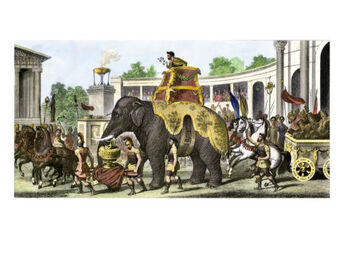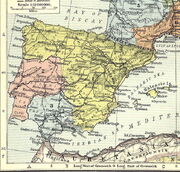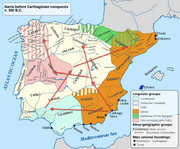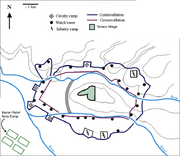
A victorious Hannibal brings trophies and slaves back to Carthago Nova
The Iberian Wars were a series of military campaigns waged against the various tribes native to Iberia by the Carthaginian General Hannibal Barca. They lasted from 213 BC to 208 BC and resulted in complete Carthaginian control of Iberia. The wars paved the way for Carthage's eventual expansion into the continent of Europe itself and served as a base for these invasions. The war culminated in the climactic siege of Tarraco in which Hannibal besieged a large Iberian garrison and fought off an even larger relief force.
Though Hannibal claimed to have waged the Iberian Wars for the glory and expansion of Carthage it is accepted that it was to boost his public image and to get himself out of debt. Still Iberia was of important strategic importance to Carthage as it was a source of wealth and manpower. In addition several of Carthage's Gallic allies had reported that various German tribes were migrating past the Rhine, pushing more and more Gauls into Iberia. Carthage feared a mass migration would result in a long bloody three-way war between the Gauls, Iberians and Carthaginians. Securing the River Ebro would serve as a border to keep out invaders.
Hannibal described the war in his book Experiences of the Iberian War which is only slightly arrogant and biased. Though there are some flaws and uncertainties it remains one of the most reliable sources with which to study the Iberian Wars.
Background
Though victorious in the Second Punic War Hannibal's financial and political troubles were many. Hanno the Great, though subdued due to Hannibal's victory, still continued to attack Hannibal and slandering him in front of the Carthaginian Senate. Adding to Hannibal's troubles was the fact that he had had to pay for his as well as his brother's armies, as the Senate (led by Hanno) had refused to pay for the Gallic auxiliaries used in Italy. This had left the Barcas deep in debt. Hannibal's ambition was to plunder some new territories and thus get him out of debt as well as expanding Cartha

A Carthaginian map of Iberia that Hannibal most likely used during his wars.
ge's sphere of influence and boosting his public image against the attacks by Hanno.
Hannibal initially had 30,000 men to command. 15,000 of these were hardened veterans from Italy and were loyal exclusively to Hannibal. He predicted his ranks would swell once he reached Iberia from various Gallic and Iberian tribes by about 2000. Another 7,000 troops were Numidian cavalry, which were the most powerful and elite in the world and had proved their worth several times against Rome. Another 5500 were slingers and archers while the remaining 500 were the 43 elephants he carried and their handlers.
The Iberian tribes had enjoyed trade and stable alliances with Carthage in the past. They had even provided Hannibal a source of manpower during his war and thousands of Iberians had fought along Carthaginians in Italy. However, with increasing pressure from Carthaginian settlers and colonists, the tribes soon found their land being slowly taken by the foreigners. Because of this relations had soured considerably between the two peoples. Thus the stage was set for Hannibal's Iberian War.
Course
Beginning: Campaign against the CeltIberi
The Celtiberi tribe had become involved in a violent conflict against their neighboor and rival, the Carpetani. However the fighting had been getting closer and closer to Carthaginian territory and in one battle the Celtiberi attacked a group of Carthaginian merchants returning from trade with another Iberian tribe. Hannibal used this as a way to enter Iberian politics and demanded that the Celtiberi and Carpetani make peace. Hannibal knew of course that they would not comply and they ignored Hannibal's orders. He threatened that if the war continued Carthage would become involved, to which the Celtiberian chieftain Garcetorix famously replied, "You are a great military leader and campaigned well against the Romans in Italy. But we are not Romans, and this is not Italy." Hannibal summoned his army from Carthago Nova only a week later and set out for the Celtiberi capitol of Numantia. Garcetorix supposedly made a truce with the Carpetani on the grounds they were both enemies of Carthage and

Map of Hannibal's campaigns in Iberia
should unite. The two tribes' combined army met the Romans at the Battle of Cissa. The result was a complete Carthaginian victory. The two tribes attempted to cross the Guadiana River however at the Battle of Guadina Crossing Hannibal caught half of the remaining armies on the south side of the river and annihilated them. Shortly afterward he crossed the river and captured Garcetorix.
Hannibal's terms of peace were relatively nice: the Carpetani and Celtiberi were to cease fighting immediately and return to their homes. They were to submit to Carthaginian command and allow Carthaginian settlers to colonize their land. However they were given autonomous rule over their towns and villages and Carthaginian settlers were strictly told to respect the native customs of the Iberians.
Campaign against the Vettones
Another tribe of the Iberians meanwhile had taken advantage of the Celtiberi and Carpetani defeats to raid and pillage their lands. As the two tribes were too weak to repel these invaders by themselves and so appealed to Hannibal for help. Hannibal obliged and marched deeper into central Iberia, and faced the Vettones at the Tajo River, where he defeated the Vettone Chieftain Maccabeo at the Battle of the Tajo River, where he used tactics similar to Trebia to defeat the vastly superior numbers of the Vettones. Hannibal then marched against the Vettones and defeated them again at the Battle of Cantabria where Maccabeo surrendered. During the battle the Iberians nearly had victory after the Iberians began pushing the Carthaginian left flank back, however a timely charge by Maharbal, Hannibal's cavalry commander at the rear of the Iberian left broke their flank and Hannibal secured victory. Hannibal's terms were nearly identical to those with the Carpetani and Celtiberi. However he forced Maccabeo to give his son, Ritul, as a hostage to be held in Carthago Nova.
Campaign against the Gallaeci
Hannibal had now secured most of Iberia for Carthage. The only area still under Iberian control was the North West territory held by the Gallecians. This territory was most desired by Hannibal as it would've provided a new coast with which to trade from. However Carthage had recently established a trade alliance with them and had declared the Gallaecian Chieftain, Voradagus, a friend of Carthage. Thus Hannibal could take no immediate action against him. However the Gallaecians had recently expelled several Vettones from neighboring areas as their own population began to grow. Hannibal used this as a reason to take a hostile position against the Gallaeci and demanded that the Gallaeci allow the Vettones back into their homeland and that any Vettones hostages and prisoners taken would be returned. Voradagus assured Hannibal that the hostages and prisoners would be returned but did not allow the vanquished Vettones back into their territory, stating that they were both conquerors and he did not have to answer to Carthage. Hannibal marched out once more to attack the Gallaeci. Though his numbers had dwindled due to the battles against the Vettones, Carpetani and Celtiberi as he marched through their territory vast numbers of Iberians joined his army, swelling his numbers to higher than when he arrived.
The first (and only) engagement in the Gallaecian Campaign nearly resulted in a defeat for Hannibal. The Gallaecians, unknown to Hannibal, had allied with their neighboors the Lusitani and the Astures. The combined armies from the three tribes numbered well over 100,000. This launched a vicious surprise attack against the Carthaginians at the Battle of Douro's Fork, where Hannibal's army was nearly defeated while setting up camp. The Gallaecian's sudden massed attack and the ferocity of the allied Lusitani quickly routed Hannibal's scouts and skirmishers (made of mainly peltasts and slingers). The massive amounts of troops overran Hannibal's front and nearly reached his camp before he was able to rally. Hannibal's skillful use of elephants (to intimidate the Iberians) led to an abrupt halt of the attack as the Iberians had never seen such beasts before. Hannibal then followed up with a charge of Numidian cavalry, which shattered the Iberian formation and routed them. The fleeing army was pursued by Hannibal until he called it off, by which time thousands of Iberians had been routed. After the defeat Hannibal threatened to devastate the Gallaecian farmlands and received their surrender. His terms on the Gallaecians and their allies were much harsher as many thousands of Carthaginians had been slain during the battle. All prisoners taken during the battle were sold into slavery while Hannibal demanded another 60,000 to be handed over. These too were sold into slavery. The Gallaecians were also to pay an indemnity of 2,000 talents of silver, 1000 upfront and monthly payments of 100 after.
Following Hannibal's victory at Douro's Fork technically all of Iberia was under his power, as he had subdued the most powerful tribes and therefore their client tribes. However pockets of resistance still existed in the region and he would have to face one more campaign before securing total domination.
The Scipian Rebellion
Though Hannnibal had sacked and destroyed Rome, removing it from the world stage, still various Romans traveled the world. Three of these were the Scipios, a family which had opposed Hannibal from the start one of them had witnessed Hannibal's decisive victory at Trebia. The three Scipios were Publius Cornelius Scipio, Gnaeus Cornelius Scipio and Publius's son, named for his father Publius. The three Scipios had been to Iberia on a Roman expedition, however shortly after the Battle of Rome the Roman soldiers in Iberia had deserted, leaving the three Scipios alone. They, however, managed to win over a few tribes by teaching them superior warfare tactics and using their mutual hate of Carthage. Shortly after the Battle of Douro's Fork the three Scipios (believed to be based somewhere in Baetica) ignited a massive rebellion by slaughtering a Carthaginian garrison at Numantia. They then annihilated a force of 15,000 Carthaginians at Belchite. Hannibal is reported to have been utterly shocked after learning of the Scipios' presence in Iberia. Another Carthaginian army of 20,000 men led by Hanno the Elder was wiped out at the Battle of Upper Baetis. With the Carthaginian losses many subdued tribes from all over Iberia joined the Scipios and rose up against the Carthaginians, and suddenly the entire peninsula was hostile territory as hundreds of Carthaginian settlers were killed by the natives.
Hannibal left Carthago Nova immediately afterward and marched out to find the Scipios, defeat and kill them. However they had moved north intending to recruit more troops in the less loyal regions of Iberia. The Scipios eluded Hannibal and gave him a taste of his own medicine after a successful ambush at the Battle of the Ebro River, in which Hannibal himself barely escaped on a racing horse. However his scattered army slowly came together and along with reinforcements from Carthago Nova moved against them again. This time the Scipios had fewer troops and they retreated northward, harassing Hannibal's forward guard as they went. They finally took refuge in Tarraco, where they waited for Hannibal. Hannibal recognized that a frontal assault on the city would cost a tremendous amount of lives and not even guarantee a victory, so he instead besieged the city. But as he had little knowledge of siege warfare he decided to take no risks and built a series of fortresses and watch towers around the city connected by a wall. He effectively cut off all supplies from entering the town and the Scipios began to search for a way out. The youngest Scipio, Publius' son, led a series of raids against the Carthaginians attempting to prevent inclosure, but the Numidian cavalry kept him at bay. However he managed to break through at an unfinished section of the wall and escape with a small contingent of Iberian cavalry. Hannibal, now expecting a relief force, built a second wall facing outwards (referred to as the Outer Wall) and filled his army between the

The defenses and fortifications built by Hannibal Barca
space between the second and the first.
Young Scipio returned with a massive relief force numbering more than 80,000 men. He launched an offensive at a weakened section of Hannibal's outer wall while his father and uncle launched a simultaneous offensive at the inner wall. The Carthaginians were pushed back however Maharbal's timely use of cavalry and elephants saved the day on the Outer Wall. With the Outer Wall secured Hannibal concentrated his forces on breaking the attackers of the Inner Wall and repulsed them. The second day the Scipios found a weakened section of the wall (the area circled) which Hannibal had hoped to hide. Natural boundaries made it impossible for a wall to be built there and the Iberians pressed in on it from all sides. The Carthaginians, exhausted from fighting and with low morale from being besieged even though they were besieging, nearly lost however Hannibal took about 4000 Numidian cavalry and rode outside his siege works and attacked the Iberians attacking the Outer Wall from the rear. This action took both defenders and attackers by surprise and the Carthaginians, seeing their leader taking such a dangerous position, fought even harder. This combined action routed the Iberian relief army which Hannibal ruthlessly rode down with his cavalry. Young Scipio however did not flee, and he supposedly challenged Hannibal himself, and after a prolonged engagement between the two was finally slain. Scipio's father, Scipio Sr., is said to have witnessed his son's defeat and death from the walls of Tarraco and wept at the sight. He took his own life shortly afterward. His brother, Gnaeus, escaped the Carthaginians dressed as a Gallic merchant.
Aftermath
Following the victory at Tarraco there was no further organized resistance to Carthaginian rule in Iberia. Hannibal had completed his father's dream of a complete conquest of Iberia. The region was divided into three Carthaginian provinces; Magna Iberia (Greater Iberia), Iberia Inferior (Lesser Iberia), and Iberia Ulterior (Farther Iberia). Though there were several lesser rebellions Carthaginian challenge was never seriously challenged again until the 2nd century. Hannibal returned to Carthage from this well out of debt, and his public figure was boosted once again, shaming Hanno the Great and his political allies a second time.
